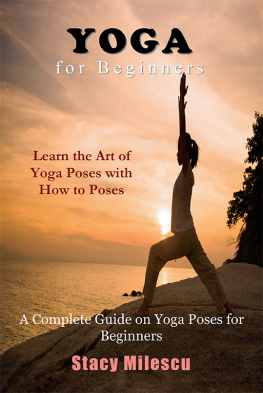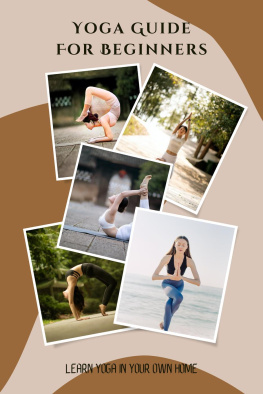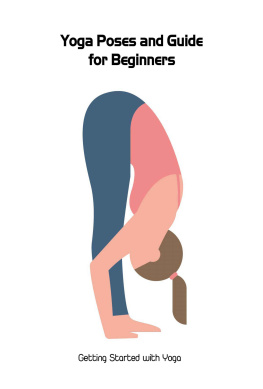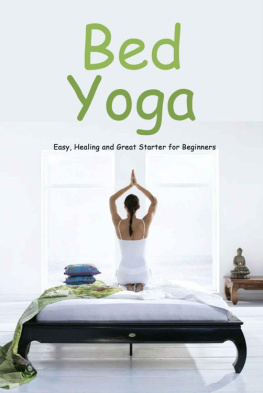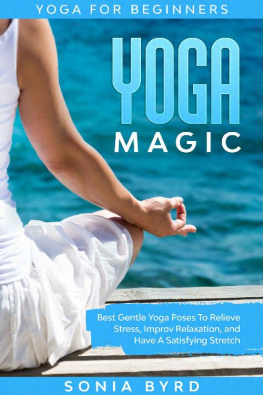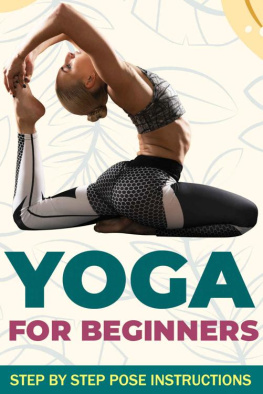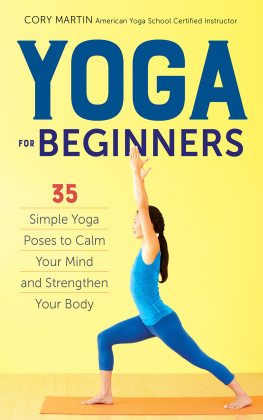Yoga for Beginners
A Complete Guide on Yoga Poses for Beginners
Stacy Milescu
This book is dedicated to anyone looking to achieve strength, flexibility, weight loss, better overall health or inner peace through the practice of yoga.
Copyright 2014 by Speedy Publishing LLC
All rights reserved. No part of this publication may be reproduced, distributed or transmitted in any form or by any means, including photocopying, recording, or other electronic or mechanical methods, without the prior written permission of the publisher, except in the case of brief quotations embodied in critical reviews and certain other noncommercial uses permitted by copyright law. For permission requests, write to the publisher, addressed Attention: Permissions Coordinator, at the address below.
Speedy Publishing LLC (c) 2014
40 E. Main St., #1156
Newark, DE 19711
www.speedypublishing.co
Ordering Information:
Quantity sales; Special discounts are available on quantity purchases by corporations, associations, and others. For details, contact the Special Sales Department at the address above.
-- 1st edition
Manufactured in the United States of America
Table of Contents
PUBLISHERS NOTES
Disclaimer
This publication is intended to provide helpful and informative material. It is not intended to diagnose, treat, cure, or prevent any health problem or condition, nor is intended to replace the advice of a physician. No action should be taken solely on the contents of this book. Always consult your physician or qualified health-care professional on any matters regarding your health and before adopting any suggestions in this book or drawing inferences from it.
The author and publisher specifically disclaim all responsibility for any liability, loss or risk, personal or otherwise, which is incurred as a consequence, directly or indirectly, from the use or application of any contents of this book.
Any and all product names referenced within this book are the trademarks of their respective owners. None of these owners have sponsored, authorized, endorsed, or approved this book.
Always read all information provided by the manufacturers product labels before using their products. The author and publisher are not responsible for claims made by manufacturers.
Digital Edition 2014
CHAPTER 1: WHAT IS YOGA AND HOW DID IT START?
Yoga is a word that you have probably heard of before, but you might not know what it actually means. The word itself, Yoga, is described as meaning "to join" or "to yoke together." This is because the practice of Yoga is intended to bring both the mind and the body together to form and behave, as a single harmonious existence.
Yoga has been around for so very long now, that its true origin has become lost through the ages of time. Some practitioners are of the belief that it could be as ancient as 10,000 years old. This is because much of the knowledge surrounding Yoga was passed on verbally, instead of through books. This let knowledge be forgotten through time, including the date of Yogas exact origins.
However, in Pakistan, there have recently been figures that were unearthed during archaeological exhibitions in the Indus Valley. Seals carved out of soapstone were unearthed with some surprising imagery on them. These seals, which were located in the Mohenjo-Daro dig site, were from the Indo-Saraswati people and each had a figure depicted upon them that was in various Yoga poses.
These stone seals can be dated back to 3,000 B.C. That is over 5,000 years ago! Because this is the oldest physical evidence, the true age of the origins of Yoga itself are suspected to go back much further to a time before documenting onto the carvings existed. If the past was anything like the present, then we know that something has to first be popular before it becomes documented for others to attempt it. Yoga could be as old as 26,000 years according to some archaeologists who have been studying its origins. Interestingly, one of the world's oldest text known as the Rig-Veda; which is a composition of hymns, is known to contain evidence of Yoga mentioned within its tomes.
Amazingly, they are identifiable. One of the figures that was discovered on the soapstone carvings is without a doubt a figure depicting that of the God Shiva, who is known as the God of Yoga. There are many attributes that support this belief, ranging from the image having three faces, to the crown of buffalo horns depicted on the seal, all known items associated with the God Shiva.
When it comes down to putting a name to the teachings behind Yoga as we know it today, then you might be interested in hearing about Patanjali. There are many people who believe that a philosopher named Patanjali is the true father of Yoga. This is because during the ancient times, Yoga poses and their techniques were not transcribed into manuals for students to learn from. Instead of manuals or posters designed to illustrate the movements, Yoga instead was taught from the teacher to their students, directly. It is believed that 2,000 years ago, Patanjali made the effort to create a documented collection of organized principles into a compilation known as Yoga Sutras. This made it easier to teach and distribute the principals of Yoga to more people across the globe.
There are essentially 3 structures that Yoga is built upon: meditation, exercise and breathing.
The sound, Aum; which is often spelled "Om," is an important aspect of the practice of Yoga. The sound is considered vital, because it is thought to be the one sound that connects the entire universe. The one word is represented as three sounds for destruction, creation and preservation. The sound, or word, is chanted often during meditations or closing of prayer during Yoga practice. It is believed that the whole of speech and thought come from one source, the sound aum.
It is further thought, that to chant the sound aum, creates a feeling of sacredness. That to achieve true understanding of the sound, it must be heard from inside of yourself, spreading out to become one with it and in so doing, becoming one with creation. It does not matter if the sound is uttered aloud, whispered under the breath or if it is only heard mentally. What matters is that the sound, aum," is uttered correctly to sound as if it rhymes with the word "home."
The recommended technique is to begin with "aum" being repeated for upwards of ten minutes out loud. Following this, repeat the chant but using only a whisper for the same duration of time. When done, repeat a final time but only within your mind are you to chant the sound, also for ten minutes. Now is when it is recommended to begin meditating on your spiritual eye. The spiritual eye is non-tangible and is thought to be located between the eyebrows. Allow yourself to sense the vibrations of the sound "aum" with the desire to expand your awareness until you are one with the very sound itself. This is the sensation that many Yoga practitioners strive to attain.
Yoga is somewhat new to the U.S. It was first reported being practiced in the United States back in the 1890's. Widespread attention and acceptance of the practice was not seen, however, until the 1960's.
Due to its popularity, Yoga has been found in many Eastern religions from Hinduism, Hari Krishna, Jainism and Sikhism. Some Christian organizations have also incorporated Yoga practice into the prayer and meditation. The latter has been of hot debate with some who take offense that a Hindu-based spiritual principal would be overcast with Christian ideology.

